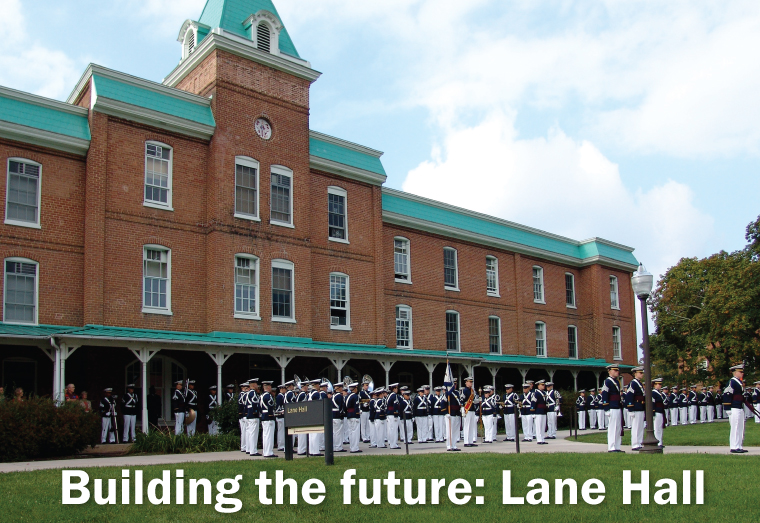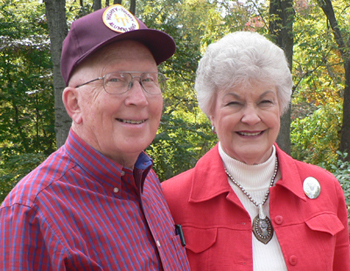 |
|

|
by ALBERT RABOTEAU
One of the oldest buildings on campus, Lane Hall still bears hundreds of signatures scratched into its bricks and mortar by cadets, some of which date back more than 100 years. Yesterday's cadets, many of whom actually roomed in the hall, are likely to gaze fondly on it when returning to campus. "It's like visiting an old homeplace," says Raymond Reed of Waynesboro, Va., (industrial engineering '57), who served in the corps' regimental band. It has been decades since he lived in Lane, but Reed still remembers old details, like the single phone for all the cadets and the maple floors of his room. "They had four-inch boards," he recalls. "We sure had to keep those things waxed." With help from Reed and others, a multimillion-dollar project that will return Lane Hall to the VTCC is in the works. Along with his wife, Peggy, Reed recently pledged $1 million in future support for the project. The plan is to update Lane Hall extensively to hold offices not only for the corps, but also for the campus-based ROTC programs for the Army, Navy, and Air Force. In addition to modernizing the building's electrical, mechanical, and information-technology systems, the renovations will include additions at the rear of Lane Hall to provide classrooms and a more suitable space for the Corps of Cadets Museum. The current museum, located in Rasche Hall, lacks appropriate climate controls and lighting. Raising millions in additional donations is crucial to financing the project. Built in 1888, Barracks No. 1 was renamed half-a-century ago for the corps' first commandant, James H. Lane, who headed the organization from the university's founding in 1872 until 1888. The building is considered the centerpiece of the Upper Quad, which is still the section of campus where the VTCC's offices and residences are clustered. While a return to Lane Hall would have symbolic meaning for the corps, officials believe the move would also help it to better showcase its program to prospective students and build on its success in increasing the number of cadets. "The renovation and addition to Lane Hall are needed to provide adequate facilities for Virginia Tech's ROTC programs, which are among the very best in the nation," says corps Commandant Maj. Gen. Jerrold P. Allen. "Completion of this project will be a strong signal of the university's commitment to the long-term viability of the corps of cadets' effort to develop leaders for the future." |
|
|
Ray '57 and Peggy Reed committed $1 million in future support to the renovation of Lane Hall. Until the project begins, money from their gift will be used for scholarships for members of the corps' Band Company, better known as the Highty-Tighties. Ray used to play clarinet in the renowned marching band and is proud of it. "I tell people I wasn't in the corps at Virginia Tech, I was in the Highty-Tighties," he says. |
|
Some cadets plan civilian careers but believe the discipline, sense of community, and leadership training offered by the corps adds to their college experience. Other cadets aspire to become military leaders, and the corps program has tight links to campus ROTC offices for all branches of the military. For the moment, however, the VTCC and ROTC programs work out of separate facilities. The corps is headquartered in Brodie Hall. The ROTC programs for the Army and Air Force are in the Military Building. The Naval/Marine ROTC program, which commissions more officers than any program in the nation other than the Naval Academy in Annapolis, is in Femoyer Hall on a fourth floor that is not accessible to the disabled. Capt. Tom Rubenstein, who heads the Navy program, says the proposed move could help him accommodate growing enrollment. "My first real graduating class was 20 years ago, and we commissioned six people. This coming year, [we] will graduate 45 people." He adds that being in the same building with the other ROTC programs and the corps would be beneficial. "The partnership between the ROTC units and the corps mission is crucial," agrees Col. Russell Walden (sociology '82), who heads the Air Force ROTC program. "Even though we're not that far away, to be co-located in one facility would be fantastic." Col. Mike Bumgarner, who heads the Army program on campus, says, "We very much like to work with our sister services and with the corps. Being able to house us all in one location would enhance our overall mission accomplishments." And that mission is becoming even more important, Bumgarner notes, because the Army increasingly has been looking to senior military colleges such as Virginia Tech, Virginia Military Institute, and the Citadel as alternative sources of officers to West Point. Members of the VTCC have a strong track record of achievement in annual competitions for military trainees. For example, at Army Summer Camp 2008, Virginia Tech cadets earned a 100 percent pass rate and the top scores in physical fitness, marksmanship, and water survival among all senior military colleges. Reed says, "The corps of cadets is the heartbeat of Virginia Tech," and he and his wife believe that "we need to reward good performance on the part of our corps leadership and ROTC leadership and say, 'Hey, you deserve better; we're going to give you the facilities you need.' I think if we do that, it will make our product even better. There's always room for improvement." |
by ALBERT RABOTEAU

|
On a typical school day, the intersection of West Campus Drive and Prices Fork Road is used by more drivers than any other gateway to campus. For years it was fairly plain compared to other popular routes, such as the Alumni Mall, which passes below the iconic Torgersen Bridge, or the entrances off Southgate Drive, which lie in the shadow of Lane Stadium.
Now, however, the nearly 10,000 drivers who enter West Campus Drive from Prices Fork Road each day during the academic year will be greeted by a new campus landmark, the West Campus Signature Gateway, thanks to the Class of '58. The Hokie Stone walls on either side of the entrance were dedicated on Oct. 3, the culmination of a $325,000 project that is one of several major gifts made by members of the Class of '58 to commemorate the 50th anniversary of their graduation. As of the dedication, the class had donated nearly $1.2 million, which is also supporting scholarships and University Libraries (see Alumni Association news). "We felt that this would be a good thing, as far as a large university project, for us to stand behind because of the visibility of it," explained Ray Powell (mechanical engineering '58), a retired assistant director of university facilities who lives in nearby Riner, Va. Important visitors to the university, such as academics who are being recruited and potential donors, often stay at the Inn at Virginia Tech and Skelton Conference Center, just off Prices Fork Road near West Campus Drive. Such visitors are likely to enter campus for the first time by West Campus Drive, so the need to improve that entrance was obvious, says Class of '58 Reunion Committee Chairman Howard Robins (aerospace engineering '58, Ph.D. physics '67). "Creating a favorable impression coming into the campus there, that sort of thing helps." In its most recent traffic surveys, the Virginia Department of Transportation (VDOT) counted 9,900 vehicles entering West Campus near Prices Fork Road, compared to 5,500 entering from Southgate Drive, and 1,800 from the Alumni Mall. Matt Gart, the university's landscape architect, says the West Campus Signature Gateway is intended to "essentially formalize that entrance and to introduce a prominence to that intersection that is in keeping with the level of traffic that the entrance receives." Employees of the university's physical plant did some of the preliminary construction. The Hokie Stone masonry was done by Robert L. Faulkner & Son of Rockbridge County, Va., and the lettering and trim on the gateway is made of pre-cast concrete from Architectural Concrete Products of Daleville, Va. There is only minimal landscaping around the gateway now because VDOT plans to upgrade the intersection next year, but more elaborate plantings will enhance the site after the road project is completed, Gart says, adding that the look of the gateway "takes some architectural cues from the campus and really gives you a sense of what the campus architecture is all about. That's important to have at an entrance." ALBERT RABOTEAU is a writer for University Development. |
||||||
